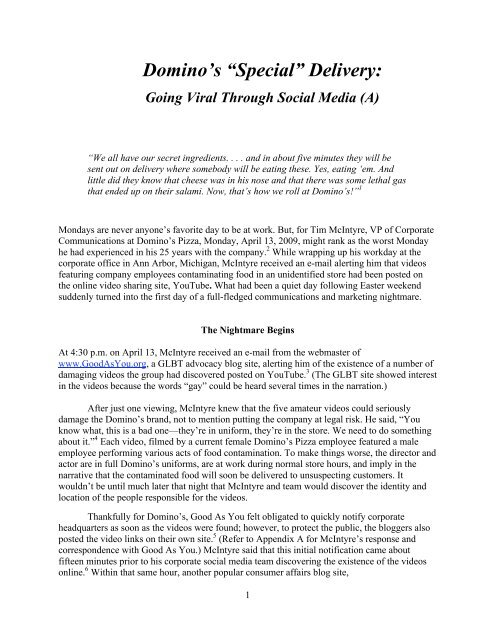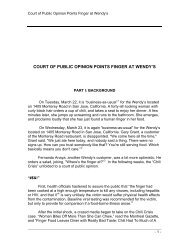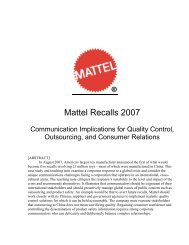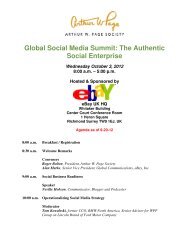Domino's “Special†Delivery: - The Arthur Page Society
Domino's “Special†Delivery: - The Arthur Page Society
Domino's “Special†Delivery: - The Arthur Page Society
Create successful ePaper yourself
Turn your PDF publications into a flip-book with our unique Google optimized e-Paper software.
<br />
Domino’s “Special” <strong>Delivery</strong>:<br />
Going Viral Through Social Media (A)<br />
“We all have our secret ingredients. . . . and in about five minutes they will be<br />
sent out on delivery where somebody will be eating these. Yes, eating ‘em. And<br />
little did they know that cheese was in his nose and that there was some lethal gas<br />
that ended up on their salami. Now, that’s how we roll at Domino’s!” 1<br />
Mondays are never anyone’s favorite day to be at work. But, for Tim McIntyre, VP of Corporate<br />
Communications at Domino’s Pizza, Monday, April 13, 2009, might rank as the worst Monday<br />
he had experienced in his 25 years with the company. 2 While wrapping up his workday at the<br />
corporate office in Ann Arbor, Michigan, McIntyre received an e-mail alerting him that videos<br />
featuring company employees contaminating food in an unidentified store had been posted on<br />
the online video sharing site, YouTube. What had been a quiet day following Easter weekend<br />
suddenly turned into the first day of a full-fledged communications and marketing nightmare.<br />
<strong>The</strong> Nightmare Begins<br />
At 4:30 p.m. on April 13, McIntyre received an e-mail from the webmaster of<br />
www.GoodAsYou.org, a GLBT advocacy blog site, alerting him of the existence of a number of<br />
damaging videos the group had discovered posted on YouTube. 3 (<strong>The</strong> GLBT site showed interest<br />
in the videos because the words “gay” could be heard several times in the narration.)<br />
After just one viewing, McIntyre knew that the five amateur videos could seriously<br />
damage the Domino’s brand, not to mention putting the company at legal risk. He said, “You<br />
know what, this is a bad one—they’re in uniform, they’re in the store. We need to do something<br />
about it.” 4 Each video, filmed by a current female Domino’s Pizza employee featured a male<br />
employee performing various acts of food contamination. To make things worse, the director and<br />
actor are in full Domino’s uniforms, are at work during normal store hours, and imply in the<br />
narrative that the contaminated food will soon be delivered to unsuspecting customers. It<br />
wouldn’t be until much later that night that McIntyre and team would discover the identity and<br />
location of the people responsible for the videos.<br />
Thankfully for Domino’s, Good As You felt obligated to quickly notify corporate<br />
headquarters as soon as the videos were found; however, to protect the public, the bloggers also<br />
posted the video links on their own site. 5 (Refer to Appendix A for McIntyre’s response and<br />
correspondence with Good As You.) McIntyre said that this initial notification came about<br />
fifteen minutes prior to his corporate social media team discovering the existence of the videos<br />
online. 6 Within that same hour, another popular consumer affairs blog site,<br />
1
www.Consumerist.com, also posted the videos on their site. Within 24 hours, McIntyre would<br />
learn that the most popular video had received 250,000 YouTube views. 7 And that was just the<br />
beginning—the videos were going viral before McIntyre’s eyes.<br />
McIntyre scanned through the past experiences of his long tenure with Domino’s to recall<br />
a situation in which he had dealt with something similar—crimes, accusations, and brand<br />
problems—something to use as a reference point on how to proceed now. When nothing similar<br />
came to mind, he realized that no plans, protocols or off-the-shelf solutions in a communications<br />
handbook could help remedy the situation before him. 8 It was up to him to pull his team together<br />
to face this unprecedented threat. But what should his first step be? And what kind of irreparable<br />
damage might Domino’s suffer if he chose the wrong course of action?<br />
<br />
<strong>The</strong> Vulgar Videos<br />
McIntyre credits two savvy readers at <strong>The</strong> Consumerist who used clues in the videos and<br />
innovative geo-mapping and investigative tools to identity the location of the videos’ creators by<br />
11:00 p.m. on Monday, just six-and-a-half hours after the videos originally surfaced. 9 <strong>The</strong> two<br />
culprits in their early 30s, Kristi Hammond and Michael Setzer, turned out to be full-time<br />
employees at a Domino’s Pizza franchise location in Conover, North Carolina.<br />
Kristi Hammond Michael Setzer<br />
Director/Narrator Actor<br />
<strong>The</strong> Videos. Hammond’s “opus piece” is a two minute, twenty-six second video named,<br />
“Dominos Pizzas Special Ingrediants” (sic) in which the two employees joke about being lazy<br />
workers and mention that their manager is in the back reading a newspaper, as usual. <strong>The</strong> video<br />
shows Setzer in vivid detail passing gas on salami and stuffing cheese for sandwiches up his<br />
nose, all while Hammond laughs and jokes in the background about this being business as usual<br />
at Domino’s. <strong>The</strong> camera then pans to the overhead order screen, which Hammond says displays<br />
the name of the customer who will receive the delivery.<br />
<strong>The</strong> other videos, called “Sneeze Sticks,” “Poopie Dishes,” and “Dominos Pizza Buger,”<br />
contain Setzer sneezing on cheesy bread, wiping his behind with a sponge and then cleaning<br />
pizza pans, and stuffing a pepper up his nose while making oven-baked sandwiches. <strong>The</strong><br />
following are a sample of quotes transcribed from one of the videos:<br />
2
<br />
Kristi: “Hello, this is Kristy back again. And here at Domino’s I like to be lazy . . . You<br />
see Michael over there hard at work—yeah, not really. Did y’all see that? He just blew a<br />
booger on those sandwiches! Do you remember the time when you sneezed? [laughter]<br />
Do it again, do it again!”<br />
Michael: “This is Michael’s special Italian sandwich.”<br />
Kristi: “And on the sandwich it goes. Now, Michael, I think that these sandwiches are<br />
going to be full of protein. . . .”<br />
Video 1: “Dominos Pizzas Special Ingrediants” Video 2: “Sneeze Sticks”<br />
Video 3: “Poopie Dishes” Video 4: “Dominos Pizza Buger”<br />
3
<br />
<br />
Domino’s Pizza Background<br />
Started in 1960 by Tom Monaghan as a single store, Domino’s Pizza quickly grew through a<br />
network of company-owned and franchise-owned stores. With more than 5,000 stores in the<br />
United States and 3,700 stores in international markets, the chain is now recognized as the world<br />
leader in pizza delivery, based on reported consumer spending. 10 Domino’s employs 125,000<br />
team members in the U.S. and more than 60 countries around the world. 11 <strong>The</strong>se employees<br />
crafted and delivered well over 400 million pizzas worldwide in 2008. 12<br />
Domino’s Pizza is a publicly traded company on the NYSE under the symbol DPZ. In<br />
2008, the company had global revenues of $1.4 billion. Sales were split with 55% in the U.S. and<br />
45% international. Between 2004 and 2008, Domino’s experienced growth primarily from<br />
international expansion, with just 39 new stores opening in the U.S. and 977 stores opening<br />
internationally. 13<br />
Franchisees. While the network of Domino’s stores consists of company- and franchise-owned<br />
stores, the latter remain the primary driver behind the company’s growth. Over 90% of U.S. and<br />
100% of international stores are franchise-owned. Franchise owners are required to operate their<br />
stores in compliance with written policies, standards, and specifications drafted by Domino’s<br />
corporate headquarters, but there are numerous of matters in which franchise owners have<br />
autonomy, including setting menu prices and hiring employees. <strong>The</strong> corporate headquarters<br />
provides franchisees with training materials, comprehensive operation manuals, and franchise<br />
development classes, but it is up to the franchisee to ensure operations and employees meet the<br />
standards of the Domino’s brand. 14<br />
Corporate Communications Team. Tim McIntyre began his tenure at Domino’s Pizza<br />
immediately after graduating from college. Twenty-five years later, as vice president of<br />
corporate communications, he now reports to the executive vice president of corporate<br />
communications, who reports to the company’s CEO. 15 McIntyre’s long, successful tenure at<br />
Domino’s contributes to what he refers to as high levels of trust and “full support from the<br />
management team” on critical issues. 16<br />
McIntyre’s internal team handles all of the company’s public relations, but partners with<br />
two external agencies for advertising and new media strategy work. 17 A new team focused<br />
specifically on social media formed at Domino’s about one month prior to the outbreak of the<br />
YouTube videos. This team had been planning to launch the company’s presence online through<br />
several social media outlets one week later—before Hammond beat them to it.<br />
<strong>The</strong> Competitive Pizza Industry<br />
Domino’s Pizza operates in the highly competitive food service industry in the Quick Service<br />
Restaurant (QSR) sector. <strong>The</strong> QSR pizza category is large and fragmented and, at $33.9 billion a<br />
year, is the second largest category in the $230.0 billion U.S. QSR sector. Competition within<br />
the QSR sector is particularly intense with regard to product quality, price, service, convenience<br />
4
and concept. Within the U.S. there are approximately 69,000 pizzerias serving about 3 billion<br />
pizzas annually, but the main pizza delivery and carry-out competitors are Domino’s, Pizza Hut<br />
and Papa John’s. Together these three comprise 47% of pizza delivery in the U.S.<br />
Internationally, Pizza Hut is the principal competitor to Domino’s. 18<br />
In general, individual customers in the QSR sector do not comprise a large portion of<br />
sales. Instead, businesses rely on volume and repeat purchase. For Domino’s Pizza, no customer<br />
accounts for more than 10% of sales. 19 If customers perceive a problem in product quality, price,<br />
service or convenience, the implications to future business success could be serious. For this<br />
reason, there is nothing more important or sacred to Domino’s than the trust of its customers. 20<br />
<br />
Social Media Players<br />
Due to the growth of social media web sites on the Internet, individuals now have the ability to<br />
instantly share messages, images, and videos with a global audience. Once a posting is made, it<br />
can also be copied by other users and uploaded to other sites, thus compounding the impact of<br />
the posting. In this case, three sites were immediately involved. www.YouTube.com had the<br />
original posting by Hammond and Setzer, and two prominent blog sites, www.GoodAsYou.org<br />
and www.consumerist.com, copied the posting and put it on their own web sites within hours.<br />
In today’s technologically advanced world, the Internet instantly connects people all over<br />
the globe. In the United States alone, estimates of broadband Internet connection show that 84<br />
million of the 119 million U.S. households, or 71%, had broadband connection to the Internet by<br />
2010. 21 With the simple click of a mouse, Internet users can quickly access unprecedented<br />
amounts of information. Much of that information is posted by companies, news outlets, or other<br />
organizations, but increasingly, information is being posted and shared by common users on<br />
social networking websites. 22<br />
Some of the most popular social networking and content sharing websites in the U.S. are<br />
Facebook, MySpace, Twitter, and YouTube. 23 Facebook boasts a network of more than 350<br />
million active users with an average of 50% logged on every day, 24 MySpace has more than 100<br />
million active users, 25 and Twitter had the largest yearly growth of members at 1,382% when it<br />
hit 7 million members in February 2009. 26 YouTube started in 2005 and is now the most widely<br />
viewed video service in the U.S. ahead of Fox Interactive Media, CBS Corporation, Yahoo!<br />
sites, and others. 27 By January of 2009, YouTube claimed more than 100 million unique U.S.<br />
visitors. 28 YouTube’s users, according to the website, watch “hundreds of millions of videos a<br />
day” on YouTube, and every minute, an additional 20 hours of video is uploaded to YouTube by<br />
users. 29<br />
<strong>The</strong> uploaded content by users on many social networking sites does not go through a<br />
formal review or approval processes by the website, so the users have great authority to post<br />
information they deem as appropriate. Once a posting is made, the content can easily be copied<br />
by other users and uploaded to other sites. This compounding effect of information being shared<br />
across websites is difficult to control and contain, so information can quickly spread and reach<br />
5
users. “Viral” is a term commonly used to describe Internet content that is quickly popularized<br />
through sharing by users. 30<br />
In this situation with Domino’s Pizza, the videos posted by Hammond and Setzer went<br />
viral. YouTube had the original posting that was uploaded by Hammond and Setzer, but within<br />
hours, two prominent blog sites—goodasyou.org and consumerist.com—copied the posting and<br />
put it on their own websites. 31 Once this occurred, Hammond and Setzer, as well as Domino’s,<br />
lost the ability to control where the videos were posted and who was able to view them. This<br />
trend of everyday users posting and sharing information, and the impact of information going<br />
viral, is summarized well by Tim McIntyre in a response to Consumerist.com about the<br />
Domino’s video pranks. McIntyre said, “<strong>The</strong> ‘challenge’ that comes with the freedom of the<br />
Internet is that any idiot with a camera and an Internet link can do stuff like this—and ruin the<br />
reputation of a brand that’s nearly 50 years old, and the reputations of 125,000 hard-working<br />
men and women across the nation and in 60 countries around the world.” 32 A single Internet<br />
user, according to McIntyre, can have an immediate impact felt around the world.<br />
<br />
Putting Out the Fire<br />
Tim McIntyre knows that the most valuable asset of Domino’s is the unfailing trust of its<br />
customers. Because of the nature of the industry it is in—home food delivery—Domino’s<br />
customers literally invite the company and its delivery drivers into their homes at the same time<br />
they hand over home addresses, credit card information, phone numbers, and names as they<br />
place an order. It was this trust that McIntyre was afraid would be forever damaged if this issue<br />
were not contained quickly and quietly. 33<br />
Instinct was telling McIntyre that the videos were most likely a hoax—a stupid prank<br />
pulled by two bored workers—but he didn’t know for sure. But, whether the videos were pranks<br />
or not, Domino’s customers would soon decide for themselves if he didn’t come up with a plan.<br />
When talking about that first day, McIntyre said, “My first reaction when I saw it was<br />
anger. I was angry because I love this place, I love this brand, I love the franchisees that I work<br />
with. And I took it personally. . . we [the immediate response team] channeled anger into<br />
action.” 34 Needless to say, Monday’s events were not a practice fire-drill for McIntyre and his<br />
team; the following weeks were going to need a lot of that action to contain this rapidly<br />
spreading media fire.<br />
Discussion Questions<br />
1. What appears to be the business problem facing Domino’s in this case?<br />
2. Who are the key stakeholders?<br />
3. What should Tim McIntyre and the communications team do first?<br />
6
<br />
4. What should Domino’s do about the employees who made the video?<br />
5. What should Domino’s do about the store where the video was made?<br />
6. What steps should Domino’s take to resolve this crisis?<br />
a. How should Domino’s respond at the local, national, and/or global level?<br />
b. What mediums should Domino’s use to communicate its message?<br />
7. How can Domino’s ensure a similar crisis does not occur in the future?<br />
a. How should Domino’s work with franchisees?<br />
7
<br />
<br />
References<br />
<br />
Appendix A <br />
1 Direct quote from Kristi Hammond, narrator of Domino’s prank video. <br />
2 Personal interview with Tim McIntyre, September 25, 2009. <br />
3 Ibid. <br />
4 Jacques, Amy. <strong>The</strong> Strategist, “Domino’s Delivers During Crisis,” Summer 2009, page 7. <br />
5 . <br />
6 Personal interview with Tim McIntyre, September 25, 2009. <br />
7 Ibid. <br />
8 Ibid. <br />
9 Jacques, Amy. <strong>The</strong> Strategist, “Domino’s Delivers During Crisis,” Summer 2009, page 8. <br />
10 Domino’s Pizza Corporate Website, About Us section: . Accessed 10/5/2009. <br />
11 Domino’s Investor Relations. . Accessed 10/5/2009. <br />
12 2008 Domino’s Pizza Annual Report. <br />
13 Ibid. <br />
14 Ibid. <br />
15 Personal interview with Tim McIntyre, September 25, 2009. <br />
16 Ibid. <br />
17 Ibid. <br />
18 Ibid. <br />
19 Ibid. <br />
20 Ibid. <br />
21 Mintel report, “Social Networking and Connectivity in the Digital Age - US - January 2008.” Section called,<br />
“Demographics and Trends.” <br />
8
<br />
. <br />
22 Ibid. <br />
23 Ibid. <br />
24 “Press Room: Statistics.” Facebook.com. Dec 2009. .<br />
25 “Fact Sheet.” MySpace.com. Dec 2009. . <br />
26 Carlson, Nicholas. “Twitter Traffic Grows 1,382% In A Year.” BusinessInsider.com. 19 Mar 2009. Dec 2009.<br />
. <br />
27 Research by comScore. Posted by emarketer.com in the article, “YouTube Hits 100 Million.” 18 March 2009.<br />
Dec 2009. . <br />
28 Ibid. <br />
29 “YouTube Fact Sheet.” YouTube.com. Dec 2009. . <br />
30 “Viral Internet Marketing: Why Viral Content is Great.” Articlesbase.com. 22 Oct 2009. Dec 2009.<br />
. <br />
31 Personal interview with Tim McIntyre, September 25, 2009. <br />
32 Letter to Jonathon Drake by Tim McIntyre on 14 Apr 2009. Posted by Chris Walters. “Consumerist Sleuths Track<br />
Down Offending Domino’s Store.” Consumerist.com. 14 Apr 2009. Dec 2009.<br />
. <br />
33 Ibid. <br />
34 Jacques, Amy. <strong>The</strong> Strategist, “Domino’s Delivers During Crisis,” Summer 2009, page 7. <br />
<br />
9














